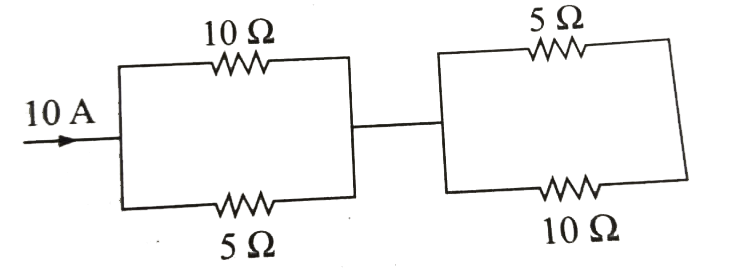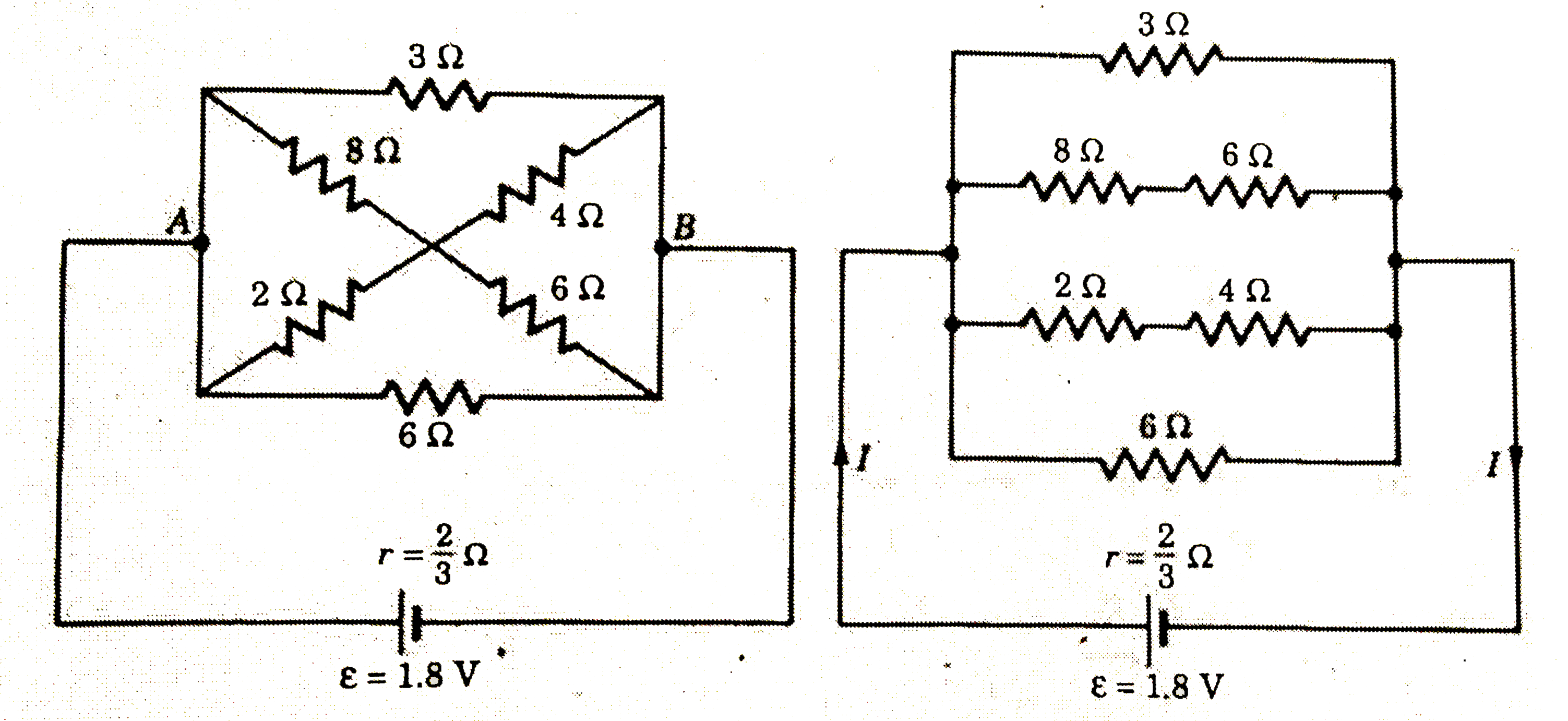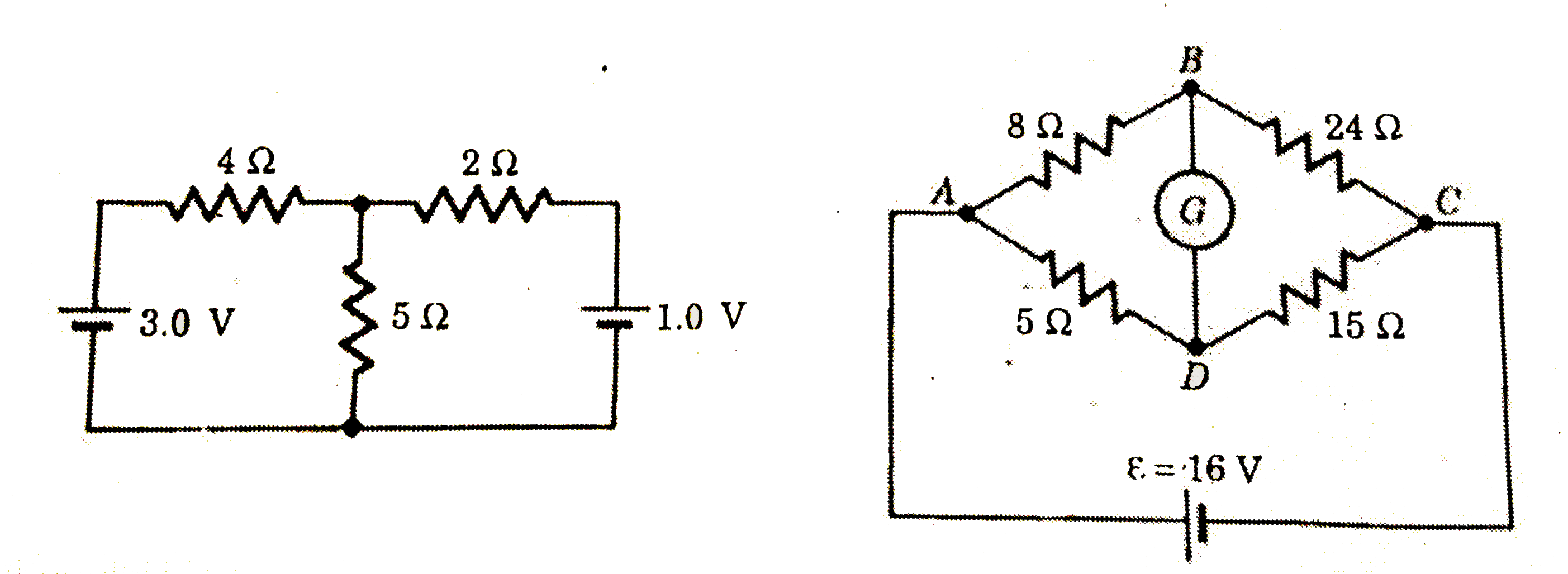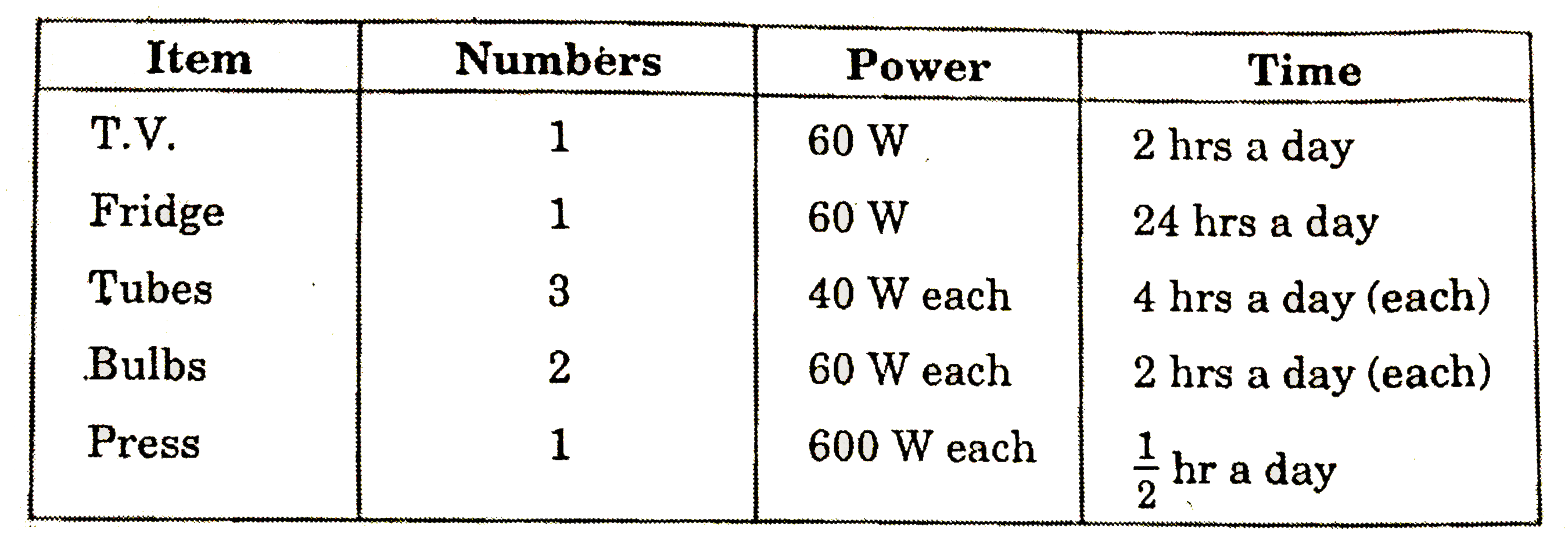Complete Solutions to All Questions of chapter HEATING EFFECT OF CURRENT of Class 12 book with complete answers and questions
| Class 12 | PHYSICS |
| Chapter | HEATING EFFECT OF CURRENT |
| SL ARORA | All Questions |
| Number Of Questions | 100 |
| Academic Year | 2023-24 |
An electric current of 4.0A flows through a `12Omega` resistor. What is the rate at which heat energy is produced in the resistor?
01:31View SolutionHow many electrons flow through the filament of a 120V and 60W electric lamp per second? Given `e=1.6xx10^(-19)C`.
01:42View SolutionCalculate the current flowing through a heater rated at `2 kW` when connected to a `300V` d.c. supply.
01:45View SolutionA current of 5.0A flows through an electric press of resistance `44Omega`. Calulate the energy consumed by the press in 5minutes.
01:29View SolutionA heating element is marked 210 V, 630 W. What is the current drawn by the element when connected to a 210 V dc mains ? What is the resistance of an element ?
01:44View SolutionA 10 V storage battery of negilgible internal resistance is connected across a 200V battery and a resistance of `50 Omega` resistor made of alloy manganin. How much heat energy is produced in the resistor in 1 h? What is the source of this energy?
01:44View SolutionAn electric motor operates on a 50V supply and draws a current of 12A. If the motor yields a mechanical power of 150W. What is the percentage efficiency of the motor?
01:27View SolutionAn electric motor operating on a `50 V dc` supply draws a current of `12 A`. If the efficiency of the motor is `30 %`,estimate the resistance of the windings of the motor.
03:42View SolutionWhich of the two has greater resistance : a 1kW heater or a 100W tungsten bulb, bath marked for 230V?
01:31View SolutionAn electric power station ( 100 MW) transmits power to a distant load through long and thin cables. Which of the two modes of transmission would result in lessere power wastage : Power transmission of : (i) 20,000 V or (ii) 200 V?
03:50View SolutionA generator is supplying power to a factory by cables of resistance `20 Omega`. If the generator is generating `50 kW` power as `5000 V`, what is the power received by factory ?
02:32View SolutionOne kilowatt electric heater is to be used with 220V d.c. supply. (i) What is the current in the heater? (ii) What is lts resistance? (iii) what is the power dissipated in the heater? (iv) How much heat in calories is produced per second? (v) How many grams of water at `100^(@)C` will be converted per minute into steam at `100^(@)C`, with the heater? Assume that the heat losses due to radiation are negligible. Latent heat of steam=540cal per gram.
02:25View SolutionTwo ribbons are gien with the following particulars:

For a fixed voltage supply. Which of the two ribbons corresponds to a greater rate of heat production?02:34View SolutionA `100W-220V` bulb is connected to 110 V source. Calculate the power consumed by the bulb.
02:46View SolutionA heater coil is rated 100W,200V. It is cut into two identical parts. Both parts are connected together in parallel, to the same sources of 200V. Calculate the energy liberated per second in the new combination.
02:21View SolutionAn electric bulb is marked 100W, 230V. If the supply voltage drops to 115V, what is the heat and light energy produced by the bulb in 20min? Calculate the current flowing through it.
02:41View SolutionBy what percentage will the illimination of the lamp decrease if the current drops by 20% ?
02:43View SolutionAn electric bulb rated for `500 W` at `100 V` is used in a circuit having a `200 V` supply. The reistance `R` that must be put in series with bulb, so that the bulb delivers `500 `W is ……….`Omega`.
04:31View SolutionThe maximum power rating of a `20 Omega` resistor is 2.0 kW. [That is, this is the maximum power the resistor can dissipate (as heat) without melting or changing in some other undersirable way]. Would you connect this resistor directly across a 300 V d.c. source of negligible internal resistance ? Explain your answer.
03:51View SolutionA 25W and 100W bulbs are joined in series and connected to the mains. Which bulb will glow brighter?
02:11View SolutionAn electric bulb and electric heater are rated `100 W,220 V and 500 W, 220 V` respectively. Both are connected in series to a `220V` d.c. mains. Calculate the power consumed by (i) electric bulb and (ii) heater
03:00View SolutionTwo heaters are marked 200V, 300W and 200 V, 600 W. If the heaters are combined in series and the combination connected to a 200 V dc supply, which heater will produce more heat ?
02:54View SolutionThree identical resistors, each of resistance R, when connected in series with a d.c. source, dissipate power X. If the resistors are connected in parallel to the same d.c. source, how much power will be dissipated ?
01:51View SolutionThe resistance of each of the three wires joined as shown in figure is `4 Omega` and each one can have a maximum power of 20 watt (otherwise it will melt). What maximum power will the whole circuit dissipate ?
 02:23View Solution
02:23View SolutionFind the heat produced per minute in each of the resistors shown in fig. 6.2.
 03:15View Solution
03:15View SolutionA 2H.P. electric motor working on 220V mains runs for 6hours a day. If electricity is rated at 50 paise per unit, find the cost of running for 30days. Also find the current through the motor when running on full capacity.
03:25View SolutionA house is fitted with `20` length of `60` watt each `10` fans consuming `0.5` ampere each an electric kettle of resistance `110 Omega`. If the energy is supplied at `120 V` and costs `150` paise `kWh`, calculate monthly bill for running these appliances for 6 hours a day (1 length = 30 days).
04:24View SolutionThere are two electric bulbs rated 60W. 110V and 100W, 110V. They are connected in series with a 220V d.c. supply. Will any bylb fuse? What will happen if they are connected in parallel with the same supply?
06:23View SolutionFind the resistance of `240 V - 200` watt electric bulb when glowing. If this resistance is `10` times the resistance at `0^(@)C` and the temperature of the glowing filament is `2000^(@)C`, then find the temperature coefficient of resistance of the filament.
03:19View SolutionA thin metallic wire of resistance `100 Omega` is immersed in a calorimeter containing 250 g of water at `10^@C` and a current of 0.5 ampere is passed through it for half an hour. If the water equivalent of the calorimeter is 10 kg, find the final temperature of water.
05:08View SolutionA copper electric kettle weighing 1000 g contains 900g of water at `20^(@)C` it takes 12 minutes to raise the temperature to `100^(@)C`. If electric energy is supplied at 210V, calculate the strength of the current, assuming that 10% heat is wasted. Specific heat of copper is 0.1.
04:13View SolutionA coil of enamelled copper wire of resistance `50Omega` is embedded in a block of ice and a potential difference of 210V applied across it. Calculate the rate of which ice melts. Latent heat of ice is 80 cal per gram.
02:14View SolutionThe heater coil of an elecric kettle is rated at 2000W,200V, How much time will in take is rasing the temperature of 1 litres of water from `20^(@)C` to `100^(@)C`. Assuming that only 80% of the total heat energy produced by the heater coil is used in raising the temperature of water. Density of water heater coil is used in raising the temperture of water. density of water =`1g cm^(-3)` and specific heat of water `= 1 "cal" g^(-1) .^(@)C^(-1)`.
04:29View SolutionA heating coil is connected in series with a resistance r. the coil is dipped in a liquid of mass 2kg and specific heat 0.5cal `g^(-1) .^(@)C^(-1)`. A potential difference of 200V is applied and the temperature of the liquid is found to increase by `60^(@)C` in 20 minutes. if R is removed, the same rise in temperature is reached in 15minutes if R is removed, the same rise in temperature is reached in 15 minutes. find the value of R.
04:07View SolutionA 10V battery of negligible internal resistance is charged by a 200V d.c. supply. If the resitance in the charging circuit is `38Omega`, what is the value of chargeing current?
01:10View SolutionA dry cell of emf 1.6V and internal resistance 0.10 ohm is connected to a resistor of resistance R ohm. If the current drawn from the cell is 2A.
02:11View SolutionA dry cell of emf `1.5 V` and internal resistance `0.10 Omega` is connected across a resistor in series with a very low resistance ammeter. When the circuit is switched on , the ammeter reading settles to a steady value of `2.0 A`.
(i) What is the steady rate of chemical energy consumption of the cell ?
(ii) What is the steady rate of energy dissipation inside the cell ?
(iii) What is the steady rate of energy dissipation inside the resistor ?
(iv) What is the steady power out put of the source?03:40View SolutionA series battery of 10 lead accumulators each of emf 2V and internal resistance 0.25ohm is charged by a 220V d.c. mains. To limit the charging current a resistance of 47.5 ohm is used in series in the charging circuit. What is (a) the power supplied by the mains and (b) power dissipated as heat? Accout for the difference of power in (a) and (b).
03:33View SolutionA series battery of six cells each of `emf 2 V` and internal resistance `0.5 Omega` is charged by a `100 V dc` supply. What resistance should be used in the charging circuit in order to limit the charging current to `8 A`. Using this relation , obtain (a) the powwer supplied by the dc source, (b) the power dissipated as heat , and (c) the chemical energy stored in the battery in `15 min`.
05:25View SolutionA battery of emf `epsilon` and internal resistance r is connected across a pure resistance device (e.f. and electric heater or an electric bulb) of resistance R. Show that the power output of the device is maximum when there is a perfect 'mathcing' between the external resistance adn the source resistance (i.e., where R=r). Determine the maximum power outpur.
Or
State and prove the maximum power theorem. show that the effciency of a battery when delivering maximum power is only 50%
(b) What is power output of the source abvoe if the battery is hosrted? what is the power dissipation inside the battery in that case?03:58View SolutionA 24 V battery of internal resistance `4.0 Omega` is connected to a variable resistance. At what value of the current drawn from the battery is the rate of heat produced in the resistor maximum?
01:46View Solution(a) An electric motor runs on a d.c. source of emf e and internal resistance r. show that the power output of the source is maximum when the current drawns by the motor is `epsilon//2r`.
(b) Show that power output of electric motor is maximum when the back emf is one-half the source emf provided the resistance of the windings of the motor is negligible.
(c) Compare and contrast carefully the situation in this excercise with that in Example 43 above.02:03View SolutionTwo batteries each of emf `epsilon` and internal resistance r, are connected in parallel. If we take current from this combination in a external resistance R, then for what value of R maximum power will beobtained? What will be this power?
04:15View SolutionTwo wires made of tinned copper having identical cross section `( = 10^(-6) m^(2))` and lengths `10 and 15 cm` are to be used as fuses. Show that the fuses will melt at the same value of current in each case.
04:17View SolutionA fuse with a circular cross - sectional radius of ` 0.15 mm` blows at `15 A`. What should be the radius of the cross section of a fuse made of the same material that blows at `30 A`?
05:46View SolutionIn the circuit shown in Fig.6.2, the heat produced in `5Omega` resistor, due to the current flowing through it is 10 calorie per second. Find the heat produced in `4Omega` resistor.
02:56View SolutionA heater is designed to operate with a power of 1000 walts in a 100 volt line. It is connected in a combinations with a resistance of 10 ohms and a resistance R to a 100 volts mains as shown in figure. What should be the value of R so that the heater operates with a power of 62.5 watts.
 . 06:22View Solution
. 06:22View SolutionFour resistances carrying a current shown in Fig. `7.41` are immersed in a box containing ice at `0^(@)C`. How much ice must be put in the box every `10 min` to keep the average quantity of ice in the box constant? Latent heat of ice is `80 calg^(-1)`.
 06:53View Solution
06:53View SolutionIn the circuit shown in figure, the `5 Omega` resistance develops `20.00 cal//s` due to the current flowing through it. The heat developed in `2 Omega` resistance (in cal`//s`) is
 04:35View Solution
04:35View SolutionThree equal resistace, each of `R` ohm, are connectedd as shown in the figure. A battery of `2V` and of internal resistance `0.1` ohm is connected across the circuit. The value of `R` for which the heat generated in the circuit maximum will be
 02:38View Solution
02:38View SolutionCalculate the current in the `3Omega` resistor and the power dissipated in the entire circuit shown in Fig. 6.10.
 04:55View Solution
04:55View SolutionCalculate the current drawn from the battery of emf 15V and internal resistance `0.5Omega` in the circuit shown in Fig. 6.12. Also find the power dissipated in thd `6Omega` resistor.
 04:21View Solution
04:21View SolutionTwo resistance `R_(1)` and `R_(2)` may be connected either in series or in parallel across a battery of zero internal resistance. It is required that the joule heating for the parallel combination be five times that for series combination. If `R_(1)` is `10Omega` find `R_(2)`.
03:12View SolutionCalculate the ratio of the heat produced in the four arms of the Wheatstone bridge shown in Fig. 6.13
 05:04View Solution
05:04View SolutionA perosn decides to use his bath tub water to generate electric power to run a 40W bulb. The bath tub is located at a height of 10m from the ground and it holds 200 litres of water. He instals a water driven wheel generator on the ground. At what rate should the water drain from the bath tub to light the bulb? How long can he keep the bulb on , if bath tub was full initially ? Efficiency of generator is `90%`. Take `g=9.8m//s^(2)`
05:00View SolutionThe walls of a closed cubical box of edge 50cm are mdade of a material of thickness 1mm and thermal conductivity `4xx10^(-4)` cal `s^(-1)cm^(-1).^(@)C^(-1)` the interior of the box maintained at `100^(@)C` above the outside temperature by a heater placed inside the box and connected acros a 400 V d.c. source. Calculate the resistance of the heater.
05:06View SolutionA copper wire having cross-sectional area `0.5mm^(2)` and a length 0.1 m is initially at `25^(@)C` and is thennallyinsulated from the surrounding. If a current of 10 A is set up in this wire,
(a) Find the time in which the wire will start melting. The change ofresistancewith the temperature of the wire maybe neglected.
(b) What will be the time taken iflength of the wire is doubled? Given for copper wire, its density `9xx10^(3) kg//^(3)` specific heat `9xx10^(-2) kcal//kg .^(@)C` melting point `1075^(@)C` and specific resistance `1.6 xx 10^(-8) Omega-m`03:52View SolutionA fuse made of lead wire has an area of cross-section `0.2mm^(2)`. On short circuiting. The current in the fuse wire reaches 30A. How long after the short circulting will the fuse begin to melt? For lead, specific heat `0.032 "cal" g^(-1) .^(@)C^(-1)`, melting point `=327^(@)C`, density =`11.34g cm^(-3)` and the resistivity `=22xx10^(-6)Omega`cm. Initial temperature of the wire is `20^(@)C`. Neglect heat losses.
07:00View SolutionAn electric tea kettle has two heating coils. When one of the coils is switched on , boiling begins in `6 min`. When the other coil is switched on , boiling begins in `8 min`. In what time will the boiling begin if both coils are switched on simultaneously (i) in series and (ii) in parallel.
06:07View SolutionHow much is the current flowing through a heater rated at 2kW when connected to a 100 V d.c. supply?
01:24View SolutionA small heating element, connected to 10V d.c. supply draws a current of 5 A. How much electric energy is supplied to heater?
01:19View SolutionTwo wires A and B of the same material and having same length, have their cross-sectional areas in the ratio `1:4`. what should be the ratio of heat produced in these wires when same voltage is applied across each ?
01:45View SolutionThere are two bulbs marked (a) 220V, 160W (b) 220V, 40W. Which has higher resistance?
01:59View SolutionTwo heater coils made of the same material are connected in parallel across the mains : the length and the diameter of one coil is double that of the other . Which of them will produce more heat?
05:05View SolutionWhat voltage drop is there across 1kW electric heater, whose resistance when hot is `40Omega`?
01:07View SolutionAn electric current of `2.0` A passes through a wire of resistance `25 Omega`. How much heat will be developed in 1 minute?
01:22View SolutionAn ammeter reads a current of 30A when it is connected across the terminals of a cell of emf 1.5V. Neglecting the meter resistance, find the amount of heat produced in the battery in 10seconds?
01:52View SolutionA coil of resistance `100 Omega` is connected across a battery of `emf 6.0 V`. Assume that the heat developed in the coil is used to raise its temperature. If the heat capacity of the coil is `4.0 J K^(-1)`, how long will it take to raise the temperature of the coil by `15^@ C`?
03:32View SolutionA `100W` and a `500W` bulbs are joined in series and connected to the mains which bulb will glow brighter?
04:16View SolutionTwo bulbs are market 220V, 100W and 220V,50W respectively. They are connected in series to 220V mains. Find the ratio of heats generated in them.
02:20View SolutionWe have a `30 W, 6 V` bulb , which we want to glow by a supply of `120 V` . What can be done for this ?
03:30View SolutionTwo electric lamps are rated as 220V. 40 W and 220V,60W. Find the heat generated per second in lamp when they are connected in series across 220V mains. Given 1 cal=4.2J.
03:18View SolutionIn a house having `220 V` line , the following appliances are operating :
(i) a ` 60 W` bulb, (ii) a `1000 W` heater , and (iii) a` 40 W` radio.
Calculate (a) the current drawn by the heater and (b) the current passing through the fuse in the main line.03:04View SolutionHow many 60W bulbs may be safely used on 220V line using a 5A fuse?
01:41View SolutionAn electric heater consists of 10m long nichrome wire of `2.5xx10^(-6)m^(2)` corss-sectional area. Calculate the wattage of the heater, when the potential difference across the heater is 200V. Given that the resistivity of nichorme `=1.1xx10^(-6)Omega`m.
02:06View SolutionThe resistances of `20Omega` are connected to a source of emf. Calculated the ratio of the heats produced in the two resistances when they are connected (i) In series and (ii) in parallel.
03:05View SolutionA line having a total resistance of `0.2` `omega` delivers `10 KW` at `220 V` to a small factory . Calculate the efficiency of transmission .
02:24View SolutionA motor operating on `120 V` draws a current of `2 A` . If the heat is developed in the motor at the rate of `9 cal s^(-1)`, what is the efficiency?
03:11View SolutionA small electric motor is rated 1/8H.P. and is running at 230V supply. How much current it will draw working at fully capacity ? What will be the cost of running it for 6 hours if electric energy is supplied at the 1.00per unit?
02:42View SolutionA 500W electric heater is designed to work with a 200 V line. If the voltage of the line drops to 160V, then what will be the percentage loss of the heat developed?
02:05View SolutionA 50 W bulb is connected in a 200V line. Determine the current flowing in it and its resistance. If 10% of the total power is converted into light, then what will be the rate of production of heat? Take `J=4.2J "cal"^(-1)`.
01:51View SolutionThree equal resistor connected in series across a source of enf together dissipate `10 Watt`. If the same resistors aer connected in parallel across the same emf, then the power dissipated will be
02:05View SolutionA room is lighted by `200W,124 V` incandescent lamps fed by a generator whose output voltage is `130 V`. The conducting wires from the generator to the user are made of aluminimum wire of total length 150 m and cross-sectional area `15 mm^(2)`. How many such length can be installed ? What is the total power consumed by the user ? sp. resistance of aluminium is `2.9 xx 10^(-4) Omega m `
06:00View SolutionAn electric heater consists of 20m length of manganin wire of 0.23 `m^(2)` cross-sectional area. Calculate the wattage of the heater when a potential difference of 200V is applied across it. Resistivity of magnanin =`4.6xx10^(-7)Omega`m.
02:22View SolutionTwo electric bulbs rated as 100W. 220V and 25W,220V are connected in series across 220V line. Calculate (i) current through(ii) Potential difference across and (iii) actual powers consumed in filament of each bulb.
03:36View SolutionFind the cost of electricity for running an electric motor of `1` hp the `5` hrs a day at the rate of Rs `1.50` per unit of electricity for the month of November
03:19View SolutionThe heater coil of an electric kettle is rated as 2000W at 200V. How much time will it take to heat one litre of water from `20^(@)C` to `100^(@)C` assming that entire electric energy liberated form the heater coil is utilised for heating water? Also calculate the resistance of the coil. Density of water is `1g cm^(-3)`.
04:19View SolutionA copper kettle weighing 1000g holds 1900g of water at `19^(@)C. it takes 12 minutes to raise the temperatureto `100^(@)C`. If energy is supplied is supplied at 210V, calculate the strength of current assuming that `10%` of heat is wasted. Secific heat of copper `=0.1"cal" g^(-1)C^(-1)`.
03:17View SolutionA 30V storage battery is being charged by 120V d.c. supply. A resistor has been connected in series with the battery to limit the charging current to 10A. Find the rate at which energy is dissipated in the resistor. If the total heat produced could be made available for heating water, how long would it take to bring 1 kg of water from `10^(@)C` to the boiling point? Specific heat of water`=1 "cal" g^(-1).^(@)C^(-1)` and from `15^(@)C` to the boiling point ? Specific heat of water =1 cal `g^(-1).^(@)C^(-1)` and 1 cal=4.2J
05:14View SolutionCalculate the power dissipated in the various resistances and the power given by the cells in the circuit shown in Fig: 6.14.
 12:31View Solution
12:31View SolutionCalculate the rate of productive of heat in the four arms of the Wheatstone's bridge shown in Fig. 6.15.
03:46View SolutionA house is fitted with 10 lamps rated 100W each, four fans each containing 0.5A. An electric kettle of resistance 100`Omega` and an electric iron of `12Omega`. If the energy is supplied at 200V and costs 50paise per kWh, calculate the bill for running the appliances four hours in a day for the month of February.
04:30View SolutionFollowing items are used in a house:

What will be the electric bill of the house for two months (each month of 30 days.) if the rate of power is Rs. 1.35 per unit?03:26View SolutionA house if fitted with a motor of 1 H.P., 5 lamps consuming 0.2 A each and two fans of 80W each. If all the appliances work for 5 hours per day, calculate the montly bill. Energy is supplied at 220V and costs 20 paise per kWh. Take one month=30 days.
03:04View SolutionA 40 V battery of internal resistance `6 Omega` is connected to a variable resistor.At what value of the current drawn from the battery is the rate of heat produced in the resistor is maximum?
01:07View SolutionAn accumulator of emf `epsilon` and internal resistance r is first connected to an external resistance `R_(1)` and then to an external resistance `R_(2)` for the same time. For what value of r the beats dissipated in `R_(1)` and `R_(2)` will be same?
02:50View SolutionA series battery of 6 lead accumulators, each of emf 2.0V and internal resistance 0.25`Omega` is charged by a 230V d.c. mains to limit the charging current, a series resistance of `53Omega` is used in the charging circuit. What is (i) power supplied by the mains (ii) power dissipated as heat? Account for the difference in the two cases.
02:11View SolutionA fuse wire of circular cross-section has a radius of 1mm. This wire blows at a current of 8A. Find the radius of the fuse wire which will blow off when a current of 1A passes through it.
01:55View SolutionA current of 2A is passed through a wire immersed in 80 g of water initially at `15.7^(@)C` in 40 minutes, the temperature of water rises to `30^(@)C` if the resistance of the wire is `0.5Omega`. Calculate the value of J.
02:22View Solution(i) A storage battery of emf `8V`, internal resistance `1 Omega` is being charged by a `120 V` d.c. source using a `15 Omega` resistor in series in the circuit. Calculate the current in the circuit (ii) terminal voltage across the battery during charging and (ii) chemical energy stored in the battery in `5` minutes.
04:00View Solution
All Questions questions and complete solutions for chapter HEATING EFFECT OF CURRENT of DHANPAT RAI & CO PHYSICS (HINGLISH) of Class 12
